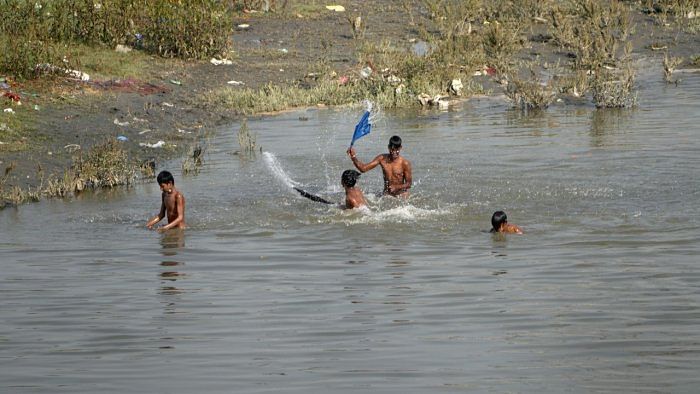
The Territorial Army company assigned to protect and clean the Yamuna floodplains in Delhi has been withdrawn, officials said on Saturday. The National Mission for Clean Ganga (NMCG) had provided the company of the Territorial Army (TA) earlier this year to boost river cleaning efforts.
In a report submitted to the National Green Tribunal (NGT) recently, the Delhi Pollution Control Committee (DPCC) said the "Territorial Army (has been) withdrawn with effect from June 30".
A senior NMCG official told PTI that the company was part of the Ecological Task Force (ETF) of the Territorial Army working for the NMCG in Kanpur, Varanasi and Prayagraj. "It was temporarily deployed for the Yamuna cleaning work in Delhi".
Also Read | NGT-appointed committee on Yamuna identifies new thrust areas for rejuvenating river
"This company was brought to Delhi to create awareness among the people... to prevent dumping of waste into the Yamuna. It was a small special drive and it's over now," the official said.
The DPCC in its report said immediate alternate measures need to be put in place following the withdrawal of the TA company.
"In addition, a separate proposal of raising a new 3 company based TA battalion for Yamuna and Najafgarh Drain in Delhi needs to be taken up with NMCG. The new battalion can be on the lines of 137 ECO TA Battalion located at Prayagraj for Ganga, funded by NMCG as a central government asset (sic)," the report read.
Another NMCG official aware of the development said it will be difficult to accommodate a request for a TA battalion for the Yamuna in Delhi and suggested that the city government deploy civil defence volunteers for this purpose. The TA company deployed in Delhi for ground-level action helped remove floating material in the river and prevent the dumping of waste. It also monitored critical vulnerable pollution hotspots through static posts and patrolled the entire stretch by foot, vehicle and boats.
The cleaning works were to be taken up in two phases: Phase 1 -- Wazirabad Barrage to ITO Barrage and Phase 2 -- ITO Barrage to Okhla Barrage. The cleaning under Phase 1 has been completed, the DPCC informed the tribunal.
The 22-kilometre stretch of the river between Wazirabad and Okhla in Delhi, which is less than two per cent of the river length, accounts for around 75 per cent of its pollution load.
Untapped waste water from unauthorised colonies and jhuggi-jhopri clusters, and poor quality of treated waste water discharged from sewage treatment plants (STPs) and common effluent treatment plants (CETPs) are the main reasons behind high levels of pollution in the river.
The Delhi government has promised to clean the Yamuna to bathing standards by February 2025. The river can be considered fit for bathing if the bio-chemical oxygen demand (BOD) is less than three milligram per litre and dissolved oxygen (DO) is greater than five milligram per litre.
Delhi generates around 792 million gallons a day (MGD) of sewage. The 35 STPs located at 20 locations across Delhi can treat up to 632 MGD of sewage and have been utilising around 86 per cent of their capacity. Around 245 MGD of sewage falls into the river directly. Government data shows that only 10 out of the 35 operational STPs in the capital meet the prescribed standards for wastewater (BOD and TSS less than 10 milligram per litre). Together, they can treat 150 million gallons of wastewater a day.
The Delhi Jal Board is upgrading and rehabilitating existing STPs to be able to meet the prescribed norms and reduce the pollution load in the Yamuna. However, several projects have been delayed due to the Covid pandemic, air pollution-related construction ban, and delay in land allotment and tree cutting permissions. The DPCC informed the NGT that the sewage treatment capacity will improve to 814 MGD by December 2023 and 964.5 MGD by June 2024.
"All the STPs (existing as well as new) with total capacity of 964.5 MGD are targeted to achieve standards prescribed by DPCC i.e BOD/TSS: 10/10 mg/l by June, 2024," it said.
The sewage treatment capacity is being enhanced by constructing new STPs at Okhla, Delhi Gate and Sonia Vihar (total 47 MGD), 40 new decentralised STPs (92 MGD), rehabilitating three existing STPs (70 MGD) and up-grading 18 existing STPs (123.5 MGD). Sewer networks have been laid in 871 of the 1,799 unauthorised colonies in Delhi.
Multiple reports submitted by the DPCC to the Union Jal Shakti Ministry have highlighted that the river cannot become fit for bathing in the absence of a minimum environment flow -- the minimum quantity of water flow that a river must have in order to preserve its ecosystems and meet the bathing standards. A study conducted by National Institute of Hydrology, Roorkee, had in 2019 recommended that 23 cubic metre per second (cumec) water (437 MGD a day) be released in the river from the Hathnikund Barrage in Haryana's Yamuna Nagar district in the lean season for sustaining downstream ecosystems.
At present, only 10 cumecs (190 MGD) is released from the barrage. A gap of 13 cumecs (247 MGD) remains.
According to the ministry, the water sharing agreement of 1994 among the riparian states of Uttarakhand, Himachal Pradesh, Uttar Pradesh, Haryana, Rajasthan and Delhi is due for revision only in 2025.
According to the DPCC, an e-flow of 23 cumecs will bring down the level of biological oxygen demand from 25 milligram per litre to 12 milligram per litre and other steps being taken will bring it down further.